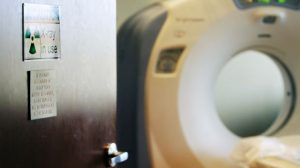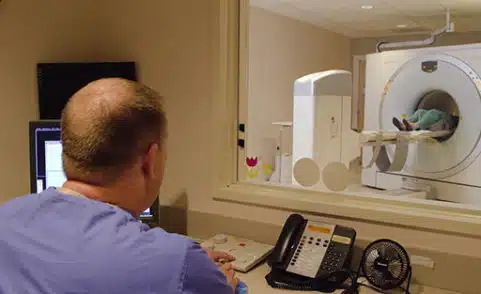
How Do I Get the Lowest CT Radiation Dose Possible?
You can’t see it or feel it, so it can be easy to forget about radiation. But from the moment you walk past the bright yellow and black warning sign on the door and enter the CT room, you’ll probably be thinking about it. So how worried should you be as you climb on the table and the technologist slides you into the round machine?
You’re getting a certain amount of radiation every day, says Dr. Alexandra Georges, a musculoskeletal radiologist at St. Luke’s RAYUS Radiology in Missouri. You get even more on a cross-country flight. It’s called background radiation, which is generally considered to be safe. “It’s too much radiation that can cause issues. It can cause cancers at a certain dose,” explains Dr. Georges.
Why Radiation Exposure Greatly Increased
Americans were exposed to 7 times more radiation in 2006 than in the 1980s according to the National Council on Radiation Protection & Measurements. Research suggests that was mainly because of increased medical radiation exposure with CT scans. Dr. Steven Pollei, a neuroradiologist at RAYUS in Federal Way, WA says doctors were ordering more scans because CT technology was advancing so quickly. “As CT scanners got faster and faster, doctors started ordering scans for more people for more indications because before we couldn’t do them.” The scans provide useful information that helps your provider plan your care. When a provider orders a CT, he or she believes the information that will be gained from the CT outweighs the risk associate with the radiation exposure.
Concerned for the safety of our patients, RAYUS led the charge in reducing radiation exposure. Two RAYUS radiologists in Indiana started a pilot project that was eventually rolled out to all RAYUS centers. The project began tracking and reporting the radiation dose exposure of each of our patients. Dr. Pollei says at RAYUS, “We were one of the first adopters of the national registry to keep track of radiation dosage.” That Dose Index Registry was established by the American College of Radiology in 2011. By 2013 more than 9.4 million CT exams had been tracked.
This vast registry now allows your radiologist to compare the radiation dose you are getting to other patients across the country who are having the same body part imaged. CT technologist Randy Jorgensen at RAYUS in Federal Way, WA monitors and records the dose after each patient scan and compares it to the national average, striving to be well below the national average. “We are on the leading front of dose reduction so we want to make sure our doses are right where they need to be, which is why we customize the dose for every patient.”
Learn how RAYUS adjusts the CT radiation dose for each patient:
What’s a Lowest Dose Protocol?
To make sure you are getting the lowest radiation dose possible from your CT scan, RAYUS follows a “Lowest Dose Protocol”. Traci Meyers, a chief technologist at RAYUS in Maple Grove, MN says technology built right into the CT scanner helps. The CT machine has software called Care Dose which fluctuates the radiation dose you’re getting based on your body size and density. Traci says her patients are often surprised with how quickly their CT scan is finished – sometimes in just a few minutes. She tells patients that over the years, technology has gotten very good. The CT scanners have gotten faster which allows the patient studies to go faster.
To make sure you are getting the lowest radiation dose possible from your CT scan, RAYUS follows a “Lowest Dose Protocol”. Traci Meyers, a chief technologist at RAYUS in Maple Grove, MN says technology built right into the CT scanner helps. The CT machine has software called Care Dose which fluctuates the radiation dose you’re getting based on your body size and density. Traci says her patients are often surprised with how quickly their CT scan is finished – sometimes in just a few minutes. She tells patients that over the years, technology has gotten very good. The CT scanners have gotten faster which allows the patient studies to go faster.
How Can I Protect Myself from Too Much Radiation?
It’s always a good idea to arm yourself with information before you arrive for your scheduled CT scan. There are some questions you can ask – either over the phone or when you arrive for your appointment – that will help you know how seriously the imaging center is taking radiation dose exposure. You might ask:
- Will you use a special shield to protect parts of my body?
- Does the CT scanner have dose reduction software?
- Is my technologist accredited for CT?
- Is this CT scan going to get the right images for my medical issue or is there a different kind of scan that might work better?
- What’s your dose reduction protocol?
Asking questions like these can help you avoid any unnecessary radiation exposure. Having the answers will help you weigh the benefits and risks of radiation exposure. When RAYUS patient Catherine Gonyea’s doctor told her she needed a CT, she says she thought about radiation, but she didn’t obsess. “I know it’s just a very small amount and if something’s going on it’s better that they look inside and find out because it could be worse than the radiation.”

